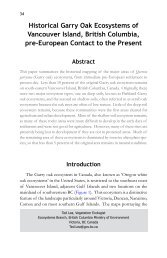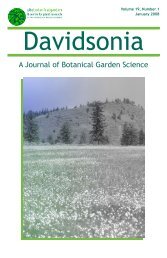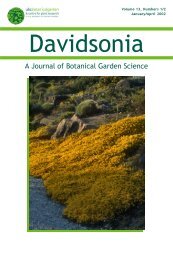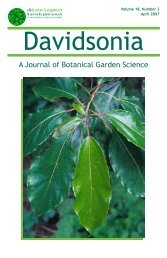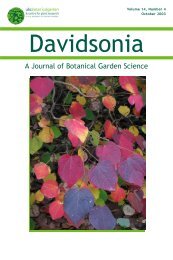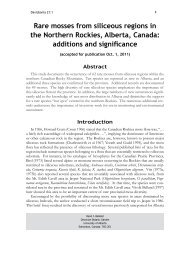Viscin Cells in the Dwarf Mistletoe Arceuthobium ... - Davidsonia
Viscin Cells in the Dwarf Mistletoe Arceuthobium ... - Davidsonia
Viscin Cells in the Dwarf Mistletoe Arceuthobium ... - Davidsonia
- No tags were found...
Create successful ePaper yourself
Turn your PDF publications into a flip-book with our unique Google optimized e-Paper software.
<strong>Davidsonia</strong> 17:3 77<br />
xylose and glucose, were also present <strong>in</strong> <strong>the</strong> mucilage. However, o<strong>the</strong>r<br />
features of <strong>the</strong> visc<strong>in</strong> cells, such as <strong>the</strong>ir cell walls, have not been well<br />
characterized. My small study on aspects of <strong>the</strong> visc<strong>in</strong> cells not directly<br />
related to <strong>the</strong> mucilage has shown that visc<strong>in</strong> cells seem to function <strong>in</strong><br />
discharge and rema<strong>in</strong> viable enough to function <strong>in</strong> adhesion to new host<br />
sites. The post discharge fate of <strong>the</strong> visc<strong>in</strong> cells has not been described,<br />
but chloroplasts were present, and <strong>the</strong> cells tested positively for <strong>the</strong><br />
operation of oxidation-reduction biochemistry when sta<strong>in</strong>ed with<br />
tetrazolium chloride. As seed is <strong>the</strong> only means by which <strong>Arceuthobium</strong><br />
can spread, an understand<strong>in</strong>g of seed development and dispersal may<br />
provide <strong>the</strong> basis for an effective control program.<br />
Methods<br />
Collection and Observation of Fruit and <strong>Visc<strong>in</strong></strong> <strong>Cells</strong> Prior<br />
to Explosive Discharge<br />
At least 30 pistillate aerial shoots of <strong>Arceuthobium</strong> americanum (<strong>the</strong><br />
lodgepole p<strong>in</strong>e dwarf mistletoe) conta<strong>in</strong><strong>in</strong>g mature fruit were marked <strong>in</strong><br />
<strong>the</strong> field and each was enclosed <strong>in</strong> cheesecloth on August 20, 2005. The<br />
contents of <strong>the</strong> cheesecloth bags were sampled daily until September 2,<br />
2005 (<strong>the</strong> day on which explosive discharge occurred) <strong>the</strong>n 1 day, 3 days<br />
and 10 days follow<strong>in</strong>g discharge. Samples from each shoot were fixed<br />
immediately <strong>in</strong> 2% paraformaldehyde + 2% glutaraldehyde <strong>in</strong> a 0.1 M<br />
phosphate buffer (pH 6.8), kept at 4 °C overnight, r<strong>in</strong>sed <strong>in</strong> <strong>the</strong> same<br />
buffer, and postfixed with 2% osmium tetroxide <strong>in</strong> <strong>the</strong> same buffer for<br />
4 hours. The material was dehydrated <strong>in</strong> an ethanol series and embedded<br />
<strong>in</strong> Spurr’s res<strong>in</strong> (Spurr 1969). Sections (2 µm thick) were obta<strong>in</strong>ed us<strong>in</strong>g<br />
a Sorvall Porter-Blum JB-4 microtome (Sorvall, Newtown, Connecticut)<br />
and affixed to gelat<strong>in</strong>-coated glass slides (Jensen 1962). The slides were<br />
sta<strong>in</strong>ed with 2% crystal violet <strong>in</strong> a 0.05 M ammonium oxalate buffer<br />
(pH 6.7) and were observed and photographed with a Nikon Optiphot<br />
compound light microscope (Nikon, Tokyo, Japan).<br />
With<strong>in</strong>-fruit visc<strong>in</strong> cell lengths were measured us<strong>in</strong>g a micrometer slide<br />
calibrated to an eyepiece scale. Average visc<strong>in</strong> cell length was determ<strong>in</strong>ed<br />
by measur<strong>in</strong>g <strong>the</strong> 10 most apical visc<strong>in</strong> cells (i.e., those cells proximal to <strong>the</strong><br />
embryo and stigma, distal to <strong>the</strong> pedicel) <strong>in</strong> sections from 10 fruits sampled<br />
on September 1, 2005 (<strong>the</strong> day <strong>in</strong> 2005 prior to explosive discharge).



